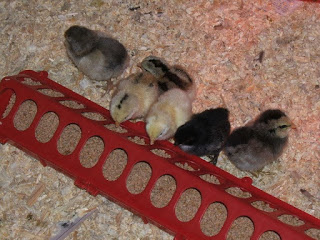Percentage of Baby Chicks and Bunnies That Die

I never saw a royal chick,
I never promise to see one
But I tin can tell yous, anyway,
I'd rather see
Than be i.
My apologies to Gelett Burgess (1886-1951) for the ane-word change in the previous poetry. I accept been thinking almost this post for several weeks, and I woke upwards in the night with the rhyme in my head.
I remember going to the local five & dime, "Newberry'southward", when I was pocket-size, and at this time of yr, in that location was a display of brightly colored chicks for sale. I call up they were ten cents each. I was enough of a farm girl to know that those colors weren't natural, and probably wouldn't concluding, only I was too plenty of a child to want i of those pastel balls of fluff. My dad, who always had the deciding vote, would say, "No. We take 500 chickens at home. If you need a pet chicken, pick one of them." And, that was it.
Not every dad felt that style. Many, many of those piffling chicks from dime stores ended upward in Easter baskets, frightened and hugged too tightly. Parents may have thought that, for x cents, a existent chick would make a great souvenir. And probably for some, they did. Having been effectually children and small animals for some years now, I can imagine that many of those little basket fluff-assurance did not live for long. They may accept perished from temperatures that were too cold or too hot; died from stress, or from beingness held too tightly, dropped, stepped on; starved to death or eaten too much of the filling of the basket in which they were presented.
Even at the age of seven or 8, I wondered what would happen to the chicks in the shop brandish when the vacation season was over. At present, I wonder, too, what happened to the chicks that may have lived to outgrow their colored feathers. And, to be honest, I wonder how the chicks were colored. I take seen chickens, Silkies in item, at Canton Fairs that are lovely pastel colors, and I wonder about that, likewise.
I have read heated discussions on the topic of the Dyed Craven; I have no plans to dye my chickens. I am curious, though. So, I began doing some earthworks, and here'due south what I constitute:
* In about half of the states in America, the sale of chicks colored in any mode is illegal. Florida, just last yr, turned over their law on the illegal sale of dyed chicks, simply that constabulary may once over again proceed the books. In New York, the land in which I live, the Ag & Market constabulary is quite specific (this is the 1/9/2013 recodifed version):
Due south 236.06 Sale OF Babe CHICKS AND BABY RABBITS.
i. NO PERSON SHALL SELL, Offer FOR SALE, BARTER OR GIVE AWAY LIVING BABY CHICKS, DUCKLINGS OR OTHER FOWL …UNLESS SUCH PERSON PROVIDES PROPER BROODER FACILITIES WHERE APPROPRIATE FOR THE Intendance OF SUCH BABY CHICKS, DUCKLINGS OR OTHER FOWL …DURING THE TIME THEY ARE IN THE POSSESSION OF SUCH PERSON. …
2. NO PERSON SHALL SELL, Offer FOR Sale, BARTER OR DISPLAY LIVING BABY CHICKS, DUCKLINGS OR OTHER FOWL …WHICH HAVE BEEN DYED, COLORED OR OTHERWISE TREATED So Equally TO IMPART TO THEM AN ARTIFICIAL Color.
Even displaying colored chicks, in New York, is illegal.
·
There seems to be no information on what happened to the penned up chicks in the dime store after Easter, nor is there anything virtually how many colored chicks died, were let loose or were given away when their feathers grew in and they became noisy chickens. I did find a great story by Sheri Dixon about some colored chicks that were given to a family living in the country, though: "Easter Chicks Gone Bad". (Y'all can imagine for yourself how some of the other chicks may accept fared.)
·
How the chicks are colored: there are two main ways—one earlier the chicks are hatch, and one taking place afterwards.
To colour a chick earlier hatching, a tiny pigsty is drilled in the eggshell of a fertile incubated egg, a few days before hatch. A syringe filled with food-class dye is injected into the egg, and the hole is plugged with paraffin. You lot can read more than Here, if you like.
To color a chick after hatching, the little bird is rinsed beginning in distilled water, then sprayed with or dipped in a solution of dye and water, with color sponged or painted onto the head. HERE's one explanation of the process.
I suppose the Silkies I saw at the County Fair had been dipped and sponged.
At this stage of my life, I don't detect the brightly colored chicks attractive. I love the natural colors of the babies in my ain coop, and find the chicks at the local feed store a delight in their xanthous or black fluff.

And, after the research I've done, the reading of articles, comments, and laws—I've realized that there are many people staunchly against the sale of dyed chicks. The animate being rights, agricultural marketing associations, and social media outlets take done a good job explaining that a royal (or pink, or blue or green) chick is not a toy, just a living creature.
I'd similar to suggest, however, that NO LIVING CHICK …dyed or not…be added to an Easter basket. If you read the entire New York State lawmaking, you will find that the showtime section pertains to "proper brooder facilities". Purchasing a chick –ANY chick with no thought to housing, proper nutrition, or care is irresponsible and…well, illegal.
The stores are full of tiny stuffed chicks and marshmallow Peeps….those make excellent, easy-care gifts. And…yeah,
I've fifty-fifty seen a purple Peep….
Source: https://www.communitychickens.com/ever-see-a-purple-chick/
0 Response to "Percentage of Baby Chicks and Bunnies That Die"
Post a Comment